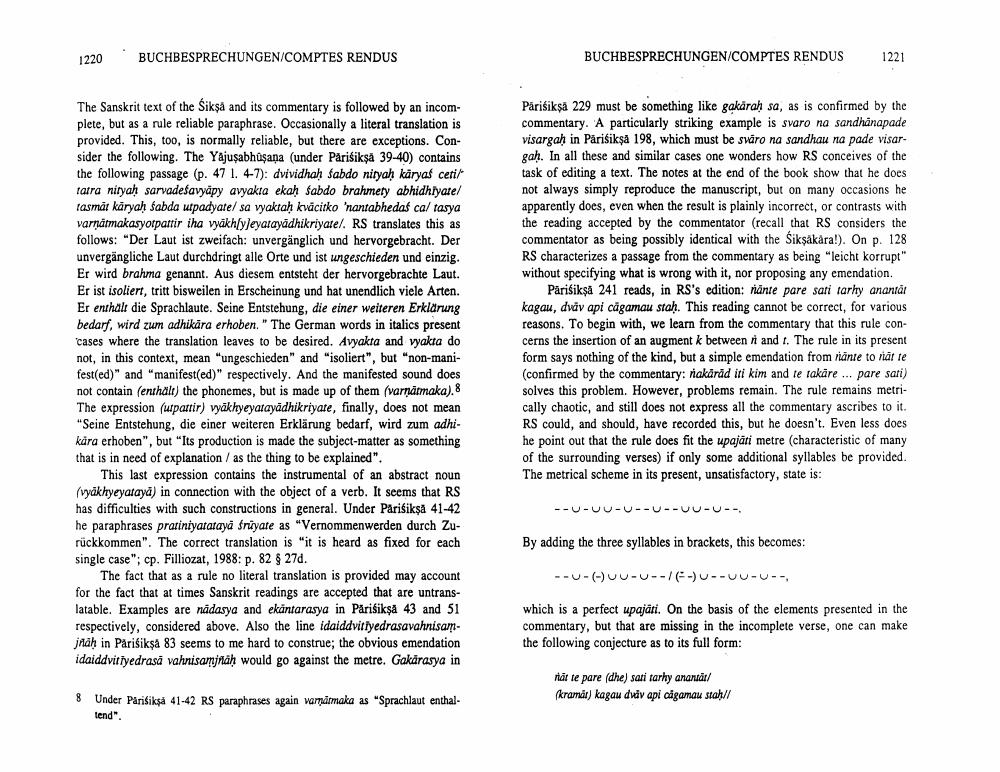Book Title: Buchbesprechungen Comptes Rendus Author(s): Johannes Bronkhorst Publisher: Johannes Bronkhorst View full book textPage 6
________________ 1220 BUCHBESPRECHUNGEN/COMPTES RENDUS BUCHBESPRECHUNGEN/COMPTES RENDUS 1221 The Sanskrit text of the Sikså and its commentary is followed by an incomplete, but as a rule reliable paraphrase. Occasionally a literal translation is provided. This, too, is normally reliable, but there are exceptions. Consider the following. The Yajuşabhūsana (under Pärisikşă 39-40) contains the following passage (p. 47 1. 4-7): dvividhah Sabdo nityah karyas ceti/ tatra nityah sarvadesavyāpy avyakta ekah Sabdo brahmety abhidhyare/ tasmāt kāryah Sabda utpadyate/ sa vyaktaḥ kvacitko 'nantabhedaf ca/ tasya varnátmakasyotpartir iha vyakh[yleyatayādhikriyatel. RS translates this as follows: "Der Laut ist zweifach: unvergänglich und hervorgebracht. Der unvergängliche Laut durchdringt alle Orte und ist ungeschieden und einzig. Er wird brahma genannt. Aus diesem entsteht der hervorgebrachte Laut. Er ist isoliert, tritt bisweilen in Erscheinung und hat unendlich viele Arten. Er enthalt die Sprachlaute. Seine Entstehung, die einer weiteren Erklärung bedarf, wird zum adhikara erhoben." The German words in italics present cases where the translation leaves to be desired. Avyakta and vyakta do not, in this context, mean "ungeschieden" and "isoliert", but "non-manifest(ed)" and "manifest(ed)" respectively. And the manifested sound does not contain (enthalt) the phonemes, but is made up of them (varnärmaka). 8 The expression (utpartir) vyakhyeyatayadhikriyate, finally, does not mean "Seine Entstehung, die einer weiteren Erklärung bedarf, wird zum adhikara erhoben", but "Its production is made the subject-matter as something that is in need of explanation / as the thing to be explained". This last expression contains the instrumental of an abstract noun (vyakhyeyataya) in connection with the object of a verb. It seems that RS has difficulties with such constructions in general. Under Parisikşå 41-42 he paraphrases pratiniyatataya friyate as "Vernommenwerden durch Zurückkommen". The correct translation is "it is heard as fixed for each single case"; cp. Filliozat, 1988: p. 82 9 27d. The fact that as a rule no literal translation is provided may account for the fact that at times Sanskrit readings are accepted that are untranslatable. Examples are nádasya and ekantarasya in Parisikşă 43 and 51 respectively, considered above. Also the line idaiddvitiyedrasavahnisamjnah in Parisiksa 83 seems to me hard to construe; the obvious emendation idaiddvitiyedrasă vahnisamjñaḥ would go against the metre. Gakärasya in Parisiksa 229 must be something like gakärah sa, as is confirmed by the commentary. A particularly striking example is svaro na sandhanapade visargah in Parisikş, 198, which must be svaro na sandhau na pade visargah. In all these and similar cases one wonders how RS conceives of the task of editing a text. The notes at the end of the book show that he does not always simply reproduce the manuscript, but on many occasions ne apparently does, even when the result is plainly incorrect, or contrasts with the reading accepted by the commentator (recall that RS considers the commentator as being possibly identical with the Sikşakára!). On p. 128 RS characterizes a passage from the commentary as being "leicht korrupt" without specifying what is wrong with it, nor proposing any emendation Parisikşă 241 reads, in RS's edition: rante pare sati tarhy anantai kagau, dváv api cagamau stah. This reading cannot be correct, for various reasons. To begin with, we learn from the commentary that this rule concerns the insertion of an augment k between 1 and 1. The rule in its present form says nothing of the kind, but a simple emendation from ante tortát te (confirmed by the commentary: nakārād iti kim and te takäre ... pare sati) solves this problem. However, problems remain. The rule remains metrically chaotic, and still does not express all the commentary ascribes to it. RS could, and should, have recorded this, but he doesn't. Even less does he point out that the rule does fit the upajäri metre (characteristic of many of the surrounding verses) if only some additional syllables be provided. The metrical scheme in its present, unsatisfactory, state is: --U-UU-U--u--UU-U-- By adding the three syllables in brackets, this becomes: --U-(-) UU-U--/ -)U--UU-U-- which is a perfect upajāti. On the basis of the elements presented in the commentary, but that are missing in the incomplete verse, one can make the following conjecture as to its full form: när te pare (dhe) sati tarhy anantat/ skramar) kagau dua api agamau stah// 8 Under Parisiksă 41-42 RS paraphrases again warmātmaka as "Sprachlaut enthaltend".Page Navigation
1 ... 4 5 6 7 8
